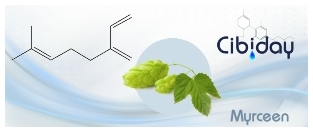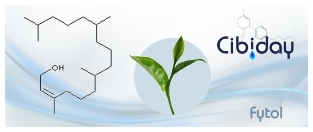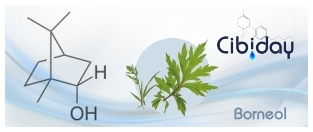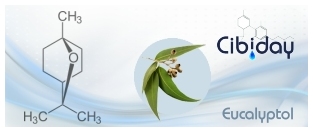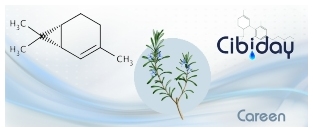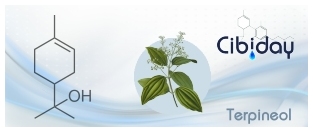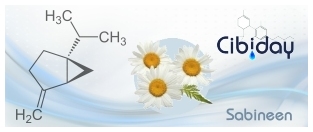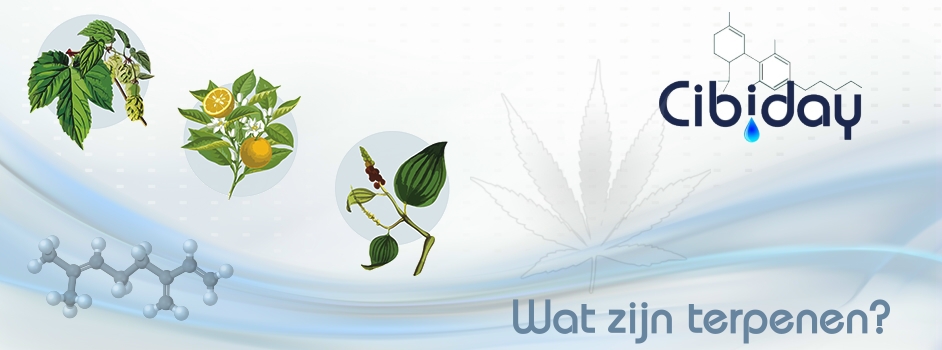
What are terpenes? How important are terpenes and what do they do?
Terpenes, also sometimes called isoprenes, are a large group of very beneficial, organic molecules which are naturally produced in thousands of plant species, including cannabis. In rare cases they can also be of animal origin, as is known of certain insects like termites and certain types of caterpillars and butterflies.
Terpenes are often highly fragrant and offer a protective function for the plant. They can for instance repel bacteria, fungi, herbivores (plant eaters) and other natural enemies by scent or rather oppositely attract beneficial insects for pollination. Besides this valuable characteristic they possess many other, very wide ranging biological functions and they help keep the plant healthy.
Healthy for the plant
Terpenes are produced in large concentrations in both hemp plants as well as in weed plants. Although it used to be believed that these components only provided a protective effect for the plant, fairly recently it was discovered that some also have many beneficial properties. They play an extremely important role in various bodily functions.
What is a terpene, a terpenol and a terpenoid?
A terpene is a simple hydrocarbon and is made up of only carbon and hydrogen. There are however also additional functional compounds with alcohol-, aldehyde- or keton groups. These derivative groups are known as terpenoles (alcohol) and terpenoids, also sometimes called isoprenoids. Often the terms terpene, terpenol and terpenoid are used interchangeably.
Terpenes and terpenoids belong to the biggest group of plant substances
Largest group of plant substances
Nowadays no less than 48,000 structures are known which means that terpenes (8,000) and terpenoids (40,000) belong to the biggest group of plant substances. Despite all these different structures they are all derived from the same central precursor (starting substance) which is known as isopentenyl pyrophosphate (IPP). This is an organic substance formed from acetic acid and is constructed out of five carbon atoms.
Based on the number of carbon atoms (C) terpenes can be classified as follows. Here the prefix in the name indicates the number of terpene units required to construct a molecule. Hemiterpenes are classified as half terpenes with five carbon atoms (C5). Mono stands for 1, sesqui means 1.5, di stands for 2, and so on.
• Hemiterpenes (C5)
• Monoterpenes (C10)
• Sesquiterpenes (C15)
• Diterpenes (C20)
• Sesterterpenes (C25)
• Triterpenes (C30)
• Sesquarterpenes (C35)
• Tetraterpenes (C40)
• Polyterpenes (>C40)
The terpenes with a higher number of carbon atoms are mainly found in resin, wax and rubber, while mono- and sesquiterpenes are important ingredients of essential oils. An example of a polyterpene is isoprene rubber while carotenes, like for instance β-carotene from carrots, are classified as tetraterpenes. A well-known monoterpene is sabinene, which occurs in laurel, camomille, peppermint and cannabis (in both hemp as well as in weed).
Biological function of mono- and sesquiterpenes
Mono- en sesquiterpenen, which can be found in various parts of the plant, form an important component of the essential (volatile) oil of the plant and is characterised by a strong, predominant scent. This strong scent is released by heat for example and hangs around the plant which means bacteria, fungi, parasites, harmful insects and other unwanted enemies are kept at a safe distance.
But the volatile terpenes can also be found attractive by certain insects which rather lures them to the plant instead of being repelled. This can be of great importance in the pollination of plants. Another biological function of the strong smelling terpenes for example is that they are released after the plant is attacked by a harmful insect. A natural enemy of the insect in question smells the scent released, is lured to the plant and eliminates the intruder.
Terpene knowledge beneficial since ancient times
The Chinese already knew that essential oils possess beneficial properties since well before 3000 BC. And they have been applied traditionally for health purposes for centuries. Especially the Egyptians were masters in their application and health scholars came from far to learn more about the effectiveness of the odorous oils.

Essential oils for health purposes in Egypt and in the Valerii Cordi Dispensatorium
In the 12th century Arnaldus de Villa Nova has described the distillation of oil from sage and rosemary and named the gained extract oleum mirabile. Furthermore more than 60 different essential oils are described in the Nuremberg edition of the Valerii Cordi Dispensatorium, which was published in 1592.
Beneficial properties of terpenes
Nowadays essential oils are also still used on a large scale and they are an important constituent in food and foodstuffs, but also in cosmetics, like for instance in perfumes and creams. They are beneficial as well in traditional medicine and alternative herbalism, like aromatherapy and they are being studied extensively for beneficial properties.
So it has for instance been established that certain odorous terpenes in skin products, like salves, massage oils and balms, can cause other active substances to be absorbed better through the skin and have a deep penetrative effect.
Terpenes in cannabis Just like cannabinoids in cannabis, terpenes each have their own specific properties. But contrary to the cannabinoids, which are mainly to be found in the plants of the cannabis genus, terpenes occur in many plant families. In cannabis terpenes work together closely with phytocannabinoids according to some researchers and they could be able to change the effect of these botanical cannabinoids. This so-called entourage effect has moreover not yet been clinically proven. Further research is certainly required.

Terpenen worden in de plakkerige trichomen (harsklieren) van de plant gevormd. Links Rotstuinkers, boven en rechts Cannabis
Terpene profiles in cannabis
Scientists have by now already discovered well over 120 different types of terpenes which occur in the trichomes (sticky resin glands) of the cannabis plant. It is largely hereditarily determined which types of terpenes are present in a particular strain. The amount and the relative ratios of the terpenes, sometimes also called a terpene profile, can however be hugely different for each plant and each strain.
Various environmental factors like the climate, the weather conditions, the age of the plant, the quality of the soil and the time of day, have an influence on the amount of terpenes that has been produced in the plant. So for instance do plants contain less terpenes at the end of the day because of evaporation.
Buying pure terpenes?
Usually cannabis contains a considerable amount of the terpene ß-caryophyllene (BCP), which greatly contributes to the scent and taste. Besides BCP there are many other terpenes in cannabis
like bisabolol, cineole (eucalyptol), delta-3-carene, limonene, linalool, myrcene, pinene, camphene, pulegone, phellandrene, sabinene, terpineol, nerolidol, phytol, borneol, humulene and caryophyllene oxide.
Besides terpene profiles, you can also buy all these terpenes individually from our assortment, all a 100% natural and of organic origin. These single terpenes are called terpene isolates.
Below follows a summary of the best known terpenes which can occur in cannabis plants. Via the clickable links "Read further..." you will be directed to the relevant information pages with an extensive description and a list of beneficial properties.
Limoneen Limoneen, ook dipenteen, carveen of citreen, is een bitter smakende monoterpeen die in veel verschillende planten voor ... | Myrceen Myrceen, ook wel β-myrceen genoemd, is een monoterpeen die wordt gezien als één van de belangrijkste terpenen die ... | Linalool Linalool is een monoterpenol die in meer dan 200 heilzame planten- en kruidensoorten en in bepaalde bomen zoals de ... |
Fytol Fytol, ook wel phytol genoemd, is een kleurloze diterpenol die verkregen wordt uit de afbraak van chlorofyl en onder ... | ß-Caryofylleen Caryofylleen, of β-caryofylleen, is een sesquiterpeen die in veel planten en kruiden voorkomt, zoals bijvoorbeeld ... | Pineen Pineen is een monoterpeen die voorkomt in dennenharsen en in de harsen van veel andere kruiden, planten en ... |
Borneol Borneol, of ook wel kamfol genoemd, is een kleurloze monoterpenol die een penetrante geur van kamfer heeft. In tegenstelling tot veel ... | Nerolidol Nerolidol, ook bekend als peruviol, is een natuurlijke sesquiterpeen die in de etherische oliën van vele soorten planten, kruiden en ... | Eucalyptol Eucalyptol, ook bekend als 1,8-cineool, is een kleurloze monoterpenoïde die aanwezig is de blauwe gomboom en andere eucalyptus ... |
Careen Careen, ook bekend als delta-3-careen, is een monoterpeen met een doordringende zoete geur. De aroma's die aan deze terpeen worden ... | Terpineol Terpineol is een natuurlijk voorkomende monoterpeen alcohol (terpenol) die wordt gevonden in de etherische olie van een ... | Sabineen Sabineen, ook wel β-thujeen genoemd, is een natuurlijk voorkomende monoterpeen die wordt gevonden in de etherische olie van vele ... |





